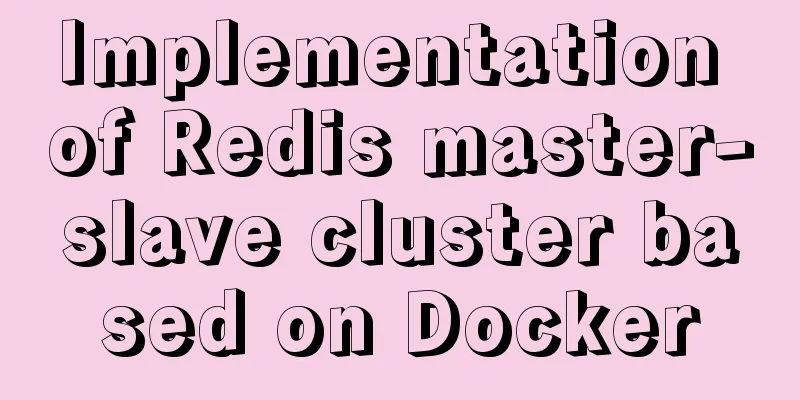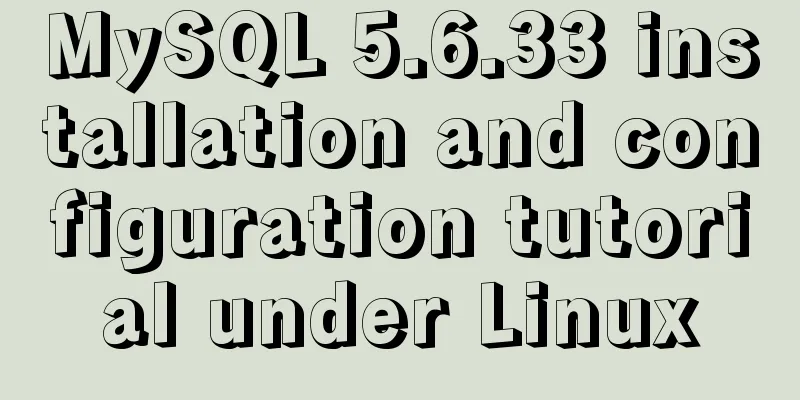Implementation of Redis master-slave cluster based on Docker

|
Recently, many friends have added me as a friend to ask about the problem of setting up a redis cluster. I think there must be something wrong with the article "Setting up a Redis cluster based on Docker" I wrote before, so I spent a few minutes browsing the previous article and summarized the following questions: The number of redis is too small, and only 3 instances are created; since there are only 3 instances, all of them can only be master nodes, and the master-slave relationship of the cluster cannot be reflected; how to build a master-slave cluster? How to allocate slave nodes? Based on the previous article, I would like to quickly go over these questions. This article is based on Docker + Redis 5.0.5 version, and creates a master-slave cluster of 6 redis instances through cluster mode. Of course, the article will point out the corresponding parameter descriptions, so that even if a cluster of 9 instances is created, the method is the same. 1. Pull the Redis imageBased on Redis: version 5.0.5, execute the following instructions: docker pull redis:5.0.5 2. Create 6 Redis containersCreate 6 Redis containers:
The execution command is as follows: docker create --name redis-node1 --net host -v /data/redis-data/node1:/data redis:5.0.5 --cluster-enabled yes --cluster-config-file nodes-node-1.conf --port 6379 docker create --name redis-node2 --net host -v /data/redis-data/node2:/data redis:5.0.5 --cluster-enabled yes --cluster-config-file nodes-node-2.conf --port 6380 docker create --name redis-node3 --net host -v /data/redis-data/node3:/data redis:5.0.5 --cluster-enabled yes --cluster-config-file nodes-node-3.conf --port 6381 docker create --name redis-node4 --net host -v /data/redis-data/node4:/data redis:5.0.5 --cluster-enabled yes --cluster-config-file nodes-node-4.conf --port 6382 docker create --name redis-node5 --net host -v /data/redis-data/node5:/data redis:5.0.5 --cluster-enabled yes --cluster-config-file nodes-node-5.conf --port 6383 docker create --name redis-node6 --net host -v /data/redis-data/node6:/data redis:5.0.5 --cluster-enabled yes --cluster-config-file nodes-node-6.conf --port 6384 Some parameter explanations:
Execute command screenshot:
3. Start the Redis containerThe execution command is as follows: docker start redis-node1 redis-node2 redis-node3 redis-node4 redis-node5 redis-node6 The startup screenshot is as follows:
4. Build a Redis clusterEnter any Redis instance: # Here we take the redis-node1 instance as an example docker exec -it redis-node1 /bin/bash Execute the command of the component cluster: # Build a cluster, 10.211.55.4 is the IP address of the current physical machine redis-cli --cluster create 10.211.55.4:6379 10.211.55.4:6380 10.211.55.4:6381 10.211.55.4:6382 10.211.55.4:6383 10.211.55.4:6384 --cluster-replicas 1 The screenshot of the execution command is as follows:
After successful creation, check the cluster node information through redis-cli: root@CentOS7:/data# redis-cli 127.0.0.1:6379> cluster nodes The screenshot of the execution command is as follows:
5. About Redis cluster constructionLet's go back to the command to create the cluster: redis-cli --cluster create 10.211.55.4:6379~6384 --cluster-replicas 1 Please pay special attention to this parameter --cluster-replicas 1. The number after the parameter indicates the master-slave ratio. For example, the 1 here means that the master-slave ratio is 1:1. What does this mean? That is, 1 master node corresponds to several slave nodes. There are 6 instances now, so the master-slave allocation is 3 master nodes and 3 slave nodes. There must be at least 3 master nodes to ensure the robustness of the cluster. What if --cluster-replicas 2? Then the master-slave ratio is 1:2, that is, 1 master node corresponds to 2 slave nodes. That is: 3 (master) + 6 (slave) = 9 Redis instances. What happens if there are less than 9 Redis instances, but the parameter is specified as 2? The error message is as follows:
The prompt is very clear, the Redis cluster requires at least 3 master nodes. Then there needs to be 6 slave nodes, so in the end: at least 9 nodes are needed. OK, I won't continue with the requirement of at least 3 master nodes, but I think 4 master nodes and 2 slave nodes should be enough, right? 4 master nodes satisfy you: # Enter a started redis instance. Here we take the redis-node1 instance as an example. docker exec -it redis-node1 /bin/bash Execute the command to build a cluster: redis-cli --cluster create 10.211.55.4:6379 10.211.55.4:6380 10.211.55.4:6381 10.211.55.4:6382 --cluster-replicas 0 Specify 4 masters without slaves, so you have 4 masters:
What about the remaining two slave nodes? Add manually. How to add? Add manually!
See the IDs of these master nodes? Just assign slaves to them. Continue to execute the following commands: redis-cli --cluster add-node 10.211.55.4:6383 10.211.55.4:6379 --cluster-slave --cluster-master-id b0c32b1dae9e7b7f7f4b74354c59bdfcaa46f30a redis-cli --cluster add-node 10.211.55.4:6384 10.211.55.4:6379 --cluster-slave --cluster-master-id 111de8bed5772585cef5280c4b5225ecb15a582e The two Redis instances are plugged into other master nodes:
Finally, we enter redis-cli and view the node information through cluster nodes:
This is the end of this article about the implementation of Redis master-slave cluster based on Docker. For more relevant Docker Redis master-slave cluster content, please search for previous articles on 123WORDPRESS.COM or continue to browse the following related articles. I hope everyone will support 123WORDPRESS.COM in the future! You may also be interested in:
|
<<: Detailed explanation of the problem when combining CSS ellipsis and padding
>>: Basic knowledge of HTML: a preliminary understanding of web pages
Recommend
Implementing custom radio and check box functions with pure CSS
1. Achieve the effect 2 Knowledge Points 2.1 <...
Detailed explanation of the correct way to configure SSL (https certificate) in Apache on Ubuntu
First, take a look at Alibaba Cloud's officia...
Detailed process record of nginx installation and configuration
Table of contents 1 Introduction to nginx 1 What ...
UDP simple server client code example
I won’t go into details about the theory of UDP. ...
The difference between redundant and duplicate indexes in MySQL
MySQL allows you to create multiple indexes on a ...
JavaScript static scope and dynamic scope explained with examples
Table of contents Preface Static scope vs. dynami...
Nginx memory pool source code analysis
Table of contents Memory Pool Overview 1. nginx d...
Understanding the MySQL query optimization process
Table of contents Parsers and preprocessors Query...
Summary of MySQL 8.0 memory-related parameters
Theoretically, the memory used by MySQL = global ...
MySQL 8.0.15 installation and configuration graphic tutorial under Win10
This article records the installation and configu...
HTML form_PowerNode Java Academy
1. Form 1. The role of the form HTML forms are us...
How to use dd command in Linux without destroying the disk
Whether you're trying to salvage data from a ...
Example code of implementing starry sky animation with CSS3 advanced LESS
This article introduces the sample code of advanc...
Detailed explanation of Vue mixin
Table of contents Local Mixin Global Mixins Summa...
Let IE6, IE7, IE8 support CSS3 rounded corners and shadow styles
I want to make a page using CSS3 rounded corners ...


















